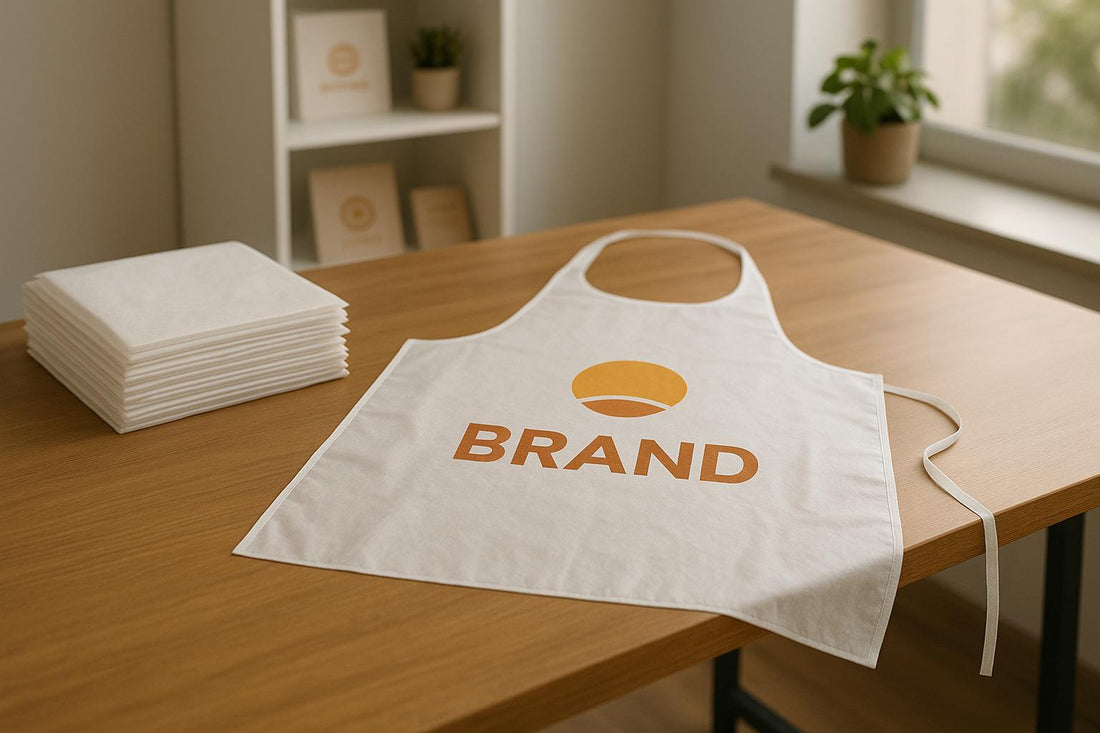
How to Customize Disposable Aprons for Branding
Share
Looking to boost your brand’s visibility with disposable aprons? Here’s how you can turn these simple garments into effective marketing tools:
- Why Customize Disposable Aprons? They protect clothing, create a professional look, and act as mobile advertisements. Perfect for food service, events, and retail.
- Material Choices: Use PE for affordability, PP for breathability, or SMS for sharp, durable prints.
- Design Tips: Keep it simple. Use vector graphics, bold logos, and clear fonts. Place logos prominently - like the chest area on bib aprons.
- Printing Methods: Choose screen printing for bulk orders, heat transfer vinyl for small batches, or direct-to-film for intricate designs.
- Quality & Safety: Ensure ink adhesion, crease resistance, and compliance with food-contact regulations.
Selecting Disposable Aprons for Custom Printing
Materials and Print Compatibility
The material of your disposable aprons plays a huge role in print quality and durability. Polyethylene (PE) is a cost-effective choice, offering reliable adhesion for most printing methods, making it perfect for single-use purposes. If you’re looking for something breathable, non-woven polypropylene (PP) works well and pairs seamlessly with techniques like screen printing and heat transfer. For those who want a more premium option, spunbond-meltblown-spunbond (SMS) materials stand out by offering sharper print clarity and greater durability.
Brand-Aligned Design Options
Your apron design should complement your brand's identity. For example, standard waist aprons are great for quick-service environments, while bib aprons provide more surface area for displaying larger logos or intricate designs. Neutral colors, like white, offer flexibility for various branding needs, while bold, vibrant colors can make your designs pop. Prioritize aprons with smooth surfaces to ensure your prints look sharp and professional. Simple, well-aligned graphics are key to maintaining clarity on disposable materials.
Up next, we’ll explore how to transform these material and design choices into powerful brand visuals.
Creating Brand Designs for Aprons
Logo and Design Requirements
Once you've chosen your materials and design style, the next step is preparing artwork that meets printing standards. Always use vector graphics - they ensure your design stays sharp and clear, no matter the size. Create your artwork using professional design software and make sure it's in a print-ready color mode. It's also smart to match your brand colors with the apron base; for example, a dark logo on a light apron creates a strong contrast and makes the design pop.
Stick to simple and bold designs. Avoid overly detailed elements, as they may not print well on disposable materials. Converting text to outlines is another helpful step, as it prevents font compatibility issues during the printing process.
Design Layout and Size Guide
Placing your logo correctly is key to boosting visibility and brand recognition. A well-balanced layout with prominent placement ensures your design grabs attention when the apron is worn. For bib aprons, for instance, the upper chest area is ideal for maximum visibility.
Here’s a quick size guide to help you determine the best dimensions and placement for your logo based on apron type:
| Apron Type | Recommended Logo Size | Placement Area |
|---|---|---|
| Bib Apron | 8" × 8" (approx. 20 × 20 cm) | Upper chest |
| Waist Apron | 6" × 4" (approx. 15 × 10 cm) | Center front |
| Full-Length | 10" × 10" (approx. 25 × 25 cm) | Chest or center |
Make sure to leave enough space between design elements to avoid a cluttered look. For text, pick a clear, legible font that stands out against the apron material. Keep in mind that disposable materials may have textures that could affect print clarity. To avoid issues with designs that reach the edges or seams, it's a good idea to include a bleed area in your artwork to account for minor printing variations.
Custom Printed Disposable Restaurant Crab Bibs Poly Aprons Single Use Plastic Adults Bibs For Eating
sbb-itb-c693c43
Printing Methods for Disposable Aprons
When it comes to printing on disposable aprons, the right method often depends on the size of the order and the complexity of the design. Let’s dive into some popular techniques and their key features.
Screen Printing Steps
Screen printing is a reliable and cost-efficient method, especially for large orders. To get started, use a 300-mesh screen coated with emulsion and let it dry for 24 hours. Align the aprons using registration marks to ensure each print is placed consistently. Apply plastisol ink at a 45° angle for an even spread, maintaining a 2mm gap for precision. Automatic presses can produce between 100 and 150 aprons per hour. Once printed, cure the designs at 320°F for 30 seconds to set the ink. For bulk orders over 500 pieces, this method costs about $0.35 per unit.
For smaller orders or simpler designs, other methods might be more practical.
Heat Transfer Vinyl Application
Heat transfer vinyl (HTV) is ideal for small batches and straightforward designs. When working with polypropylene aprons, set your press to 305°F and apply medium pressure (20–25kg) for 10–15 seconds. A 5"x7" mini heat press is particularly useful for curved surfaces, such as nylon straps that are 1.5 inches wide. For materials with textured surfaces, silicone conformal pads can help distribute pressure evenly.
If your design involves intricate details or multiple colors, Direct-to-Film printing might be the better option.
Direct-to-Film Transfer Process
Direct-to-Film (DTF) printing is perfect for capturing complex, colorful designs. This method uses CMYK+white ink layers at a resolution of 1440dpi on PET film, achieving up to 98% Pantone color accuracy. DTF prints are durable, withstanding 50–100 washes without cracking. Start by applying a pre-treatment spray at a 5% concentration, then press the transfer at 320°F–338°F for 15–20 seconds.
For medium-sized orders, DTF printing costs around $0.85 per unit. While screen prints score slightly higher (4.5/5) in rub tests compared to DTF’s 3.8/5, DTF has a lower waste rate - only 5% ink waste, compared to screen printing’s 15%.
Each printing method has its strengths, so choosing the right one depends on your specific needs and priorities.
Quality Standards and Safety Rules
Print Quality Testing
When it comes to print quality, a few key factors need attention: ink adhesion, crease resistance, and color retention. It's important to assess how well the ink sticks to the apron material, whether the fabric resists creasing, and if the colors stay vibrant after being handled or washed. To catch any potential problems early, conduct controlled tests like folding, washing, and visual inspections, all guided by clear acceptance criteria.
Safety and Legal Requirements
Once print quality checks are complete, the focus shifts to safety and compliance. For disposable aprons used in food service or other sensitive environments, ensure that both the inks and materials meet food-contact regulations. Additionally, follow workplace safety standards, such as maintaining proper ventilation and keeping up-to-date material safety data sheets. Regularly reviewing and documenting these safety measures ensures the final product not only meets legal requirements but is also safe for use.
Conclusion
Adding branded elements to disposable aprons is a smart way to combine practicality with increased business visibility. To achieve this, careful attention to material selection, design, and quality standards is essential.
As outlined earlier, the benefits for businesses are clear. Ensuring proper ink adhesion and meeting safety standards are key factors in creating these customized aprons. They not only maintain brand consistency but also enhance recognition in food service and retail settings, effectively turning each apron into a mobile advertisement.
Every step in the customization process plays a role in strengthening your brand's message. The right balance between visual appeal and functionality makes these aprons a powerful tool - not just for protection, but also for promoting your brand in a dynamic and impactful way.
FAQs
How can I ensure high-quality and long-lasting prints on disposable aprons?
To get durable, sharp prints on disposable aprons, start by selecting high-quality materials like non-woven polypropylene that work well with your chosen printing method. Make sure your design is high-resolution and that any logos or branding are sized correctly for maximum clarity. For the actual printing, go with professional techniques such as screen printing or heat transfer, as these are effective for disposable surfaces.
Before committing to a full production run, it’s a good idea to test a sample to ensure the design adheres well and looks as expected. Once printed, store the aprons in a cool, dry place to preserve print quality until they’re ready to use.
How can businesses ensure their customized aprons comply with food-contact safety standards?
To make sure your customized aprons comply with food-contact safety standards, begin by choosing materials that are safe for food environments, non-toxic, and durable. If the aprons are intended for use in kitchens or food prep areas, prioritize those made from FDA-approved or food-safe materials.
It’s also important to verify that any logos or designs printed on the aprons use food-safe inks and dyes. This step helps maintain both safety and hygiene standards. To be extra cautious, ask your supplier or manufacturer for documentation or certifications confirming that the aprons meet U.S. food-contact safety regulations.
What should I consider when selecting a printing method for custom apron designs?
When deciding on the best printing method for your custom disposable aprons, it's important to weigh factors like order size, design complexity, and budget. For larger quantities with straightforward designs, screen printing is a popular choice. It’s budget-friendly and delivers bold, vibrant results. However, if your design involves intricate details or multiple colors, digital printing might be the way to go, as it provides greater precision and versatility.
You’ll also want to consider the apron material and how well the chosen printing method will adhere to it. For instance, certain techniques are better suited for synthetic fabrics, while others perform best on cotton blends. Taking these elements into account will help ensure your branding looks polished and stands the test of time.
